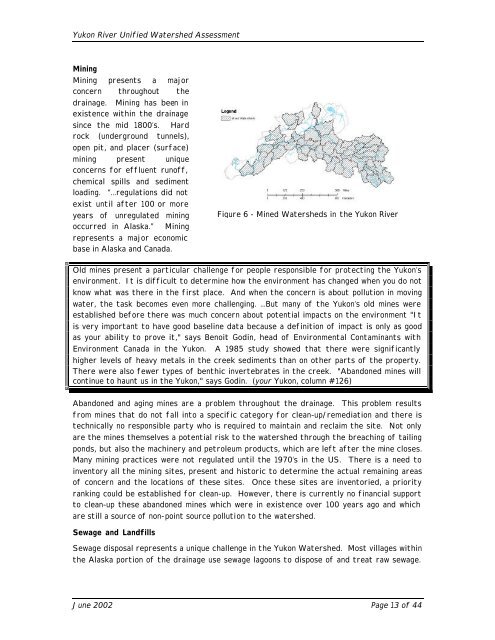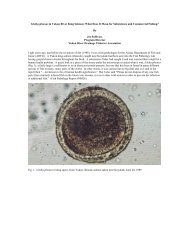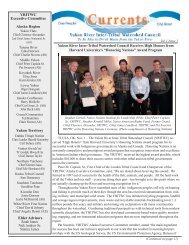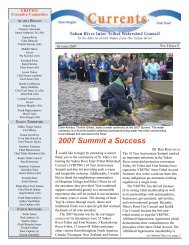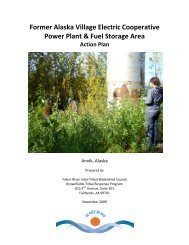Yukon River Unified Watershed Assessment - Yukon River Inter ...
Yukon River Unified Watershed Assessment - Yukon River Inter ...
Yukon River Unified Watershed Assessment - Yukon River Inter ...
Create successful ePaper yourself
Turn your PDF publications into a flip-book with our unique Google optimized e-Paper software.
<strong>Yukon</strong> <strong>River</strong> <strong>Unified</strong> <strong>Watershed</strong> <strong>Assessment</strong><br />
Mining<br />
Mining presents a major<br />
concern throughout the<br />
drainage. Mining has been in<br />
existence within the drainage<br />
since the mid 1800’s. Hard<br />
rock (underground tunnels),<br />
open pit, and placer (surface)<br />
mining present unique<br />
concerns for effluent runoff,<br />
chemical spills and sediment<br />
loading. “…regulations did not<br />
exist until after 100 or more<br />
years of unregulated mining<br />
occurred in Alaska.” Mining<br />
represents a major economic<br />
base in Alaska and Canada.<br />
Old mines present a particular challenge for people responsible for protecting the <strong>Yukon</strong>’s<br />
environment. It is difficult to determine how the environment has changed when you do not<br />
know what was there in the first place. And when the concern is about pollution in moving<br />
water, the task becomes even more challenging. …But many of the <strong>Yukon</strong>’s old mines were<br />
established before there was much concern about potential impacts on the environment "It<br />
is very important to have good baseline data because a definition of impact is only as good<br />
as your ability to prove it," says Benoit Godin, head of Environmental Contaminants with<br />
Environment Canada in the <strong>Yukon</strong>. A 1985 study showed that there were significantly<br />
higher levels of heavy metals in the creek sediments than on other parts of the property.<br />
There were also fewer types of benthic invertebrates in the creek. "Abandoned mines will<br />
continue to haunt us in the <strong>Yukon</strong>," says Godin. (your <strong>Yukon</strong>, column #126)<br />
Abandoned and aging mines are a problem throughout the drainage. This problem results<br />
from mines that do not fall into a specific category for clean-up/remediation and there is<br />
technically no responsible party who is required to maintain and reclaim the site. Not only<br />
are the mines themselves a potential risk to the watershed through the breaching of tailing<br />
ponds, but also the machinery and petroleum products, which are left after the mine closes.<br />
Many mining practices were not regulated until the 1970’s in the US. There is a need to<br />
inventory all the mining sites, present and historic to determine the actual remaining areas<br />
of concern and the locations of these sites. Once these sites are inventoried, a priority<br />
ranking could be established for clean-up. However, there is currently no financial support<br />
to clean-up these abandoned mines which were in existence over 100 years ago and which<br />
are still a source of non-point source pollution to the watershed.<br />
Sewage and Landfills<br />
Figure 6 - Mined <strong>Watershed</strong>s in the <strong>Yukon</strong> <strong>River</strong><br />
Sewage disposal represents a unique challenge in the <strong>Yukon</strong> <strong>Watershed</strong>. Most villages within<br />
the Alaska portion of the drainage use sewage lagoons to dispose of and treat raw sewage.<br />
June 2002 Page 13 of 44


